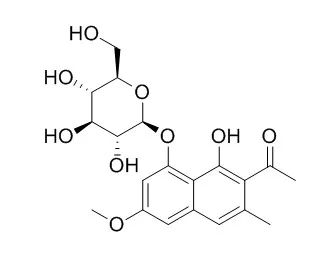| In vitro: |
| Anal. Methods-UK. 2014, 6(10):3353-9. | | The screening of potential α-glucosidase inhibitors from the Polygonum multiflorum extract using ultrafiltration combined with liquid chromatography-tandem mass spectrometry[Reference: WebLink] |
α-Glucosidase inhibitors have been used for the management of type 2 diabetes (T2DM) for a long time. The natural α-glucosidase inhibitors from Chinese herbal medicine have become an attractive therapeutic approach for treating T2DM due to their low toxicity.
METHODS AND RESULTS:
In this study, a new kind of in vitro α-glucosidase inhibition assay based on using maltose as the substrate was developed, and this new established method was used to determine the α-glucosidase inhibitory activities of Polygonum multiflorum and four anthraquinone compounds. As a result, Polygonum multiflorum showed 50% α-glucosidase inhibition at the concentration of 0.0032 mg mL−1 and four anthraquinone compounds including emodin, aloe-emodin, physcion and rhein showed strong α-glucosidase inhibitory activities with IC50 values ranging from 4.12 μM to 5.68 μM, respectively. Moreover, the centrifugal ultrafiltration with LC-ESI-MSn was used to screen and identify active α-glucosidase inhibitors from Polygonum multiflorum extract and nine small-molecule active compounds were successfully identified as potential α-glucosidase inhibitors.
CONCLUSIONS:
Five compounds belonged to the anthraquinone group including emodin, physcion, aloe-emodin, rhein and physcion-8-O-glucoside, while the others were catechin, resveratrol, 2,3,5,4′-tetrahydroxystilbene-2-O-glucoside and Torachrysone 8-O-glucoside. |
|






 Cell. 2018 Jan 11;172(1-2):249-261.e12. doi: 10.1016/j.cell.2017.12.019.IF=36.216(2019)
Cell. 2018 Jan 11;172(1-2):249-261.e12. doi: 10.1016/j.cell.2017.12.019.IF=36.216(2019) Cell Metab. 2020 Mar 3;31(3):534-548.e5. doi: 10.1016/j.cmet.2020.01.002.IF=22.415(2019)
Cell Metab. 2020 Mar 3;31(3):534-548.e5. doi: 10.1016/j.cmet.2020.01.002.IF=22.415(2019) Mol Cell. 2017 Nov 16;68(4):673-685.e6. doi: 10.1016/j.molcel.2017.10.022.IF=14.548(2019)
Mol Cell. 2017 Nov 16;68(4):673-685.e6. doi: 10.1016/j.molcel.2017.10.022.IF=14.548(2019)